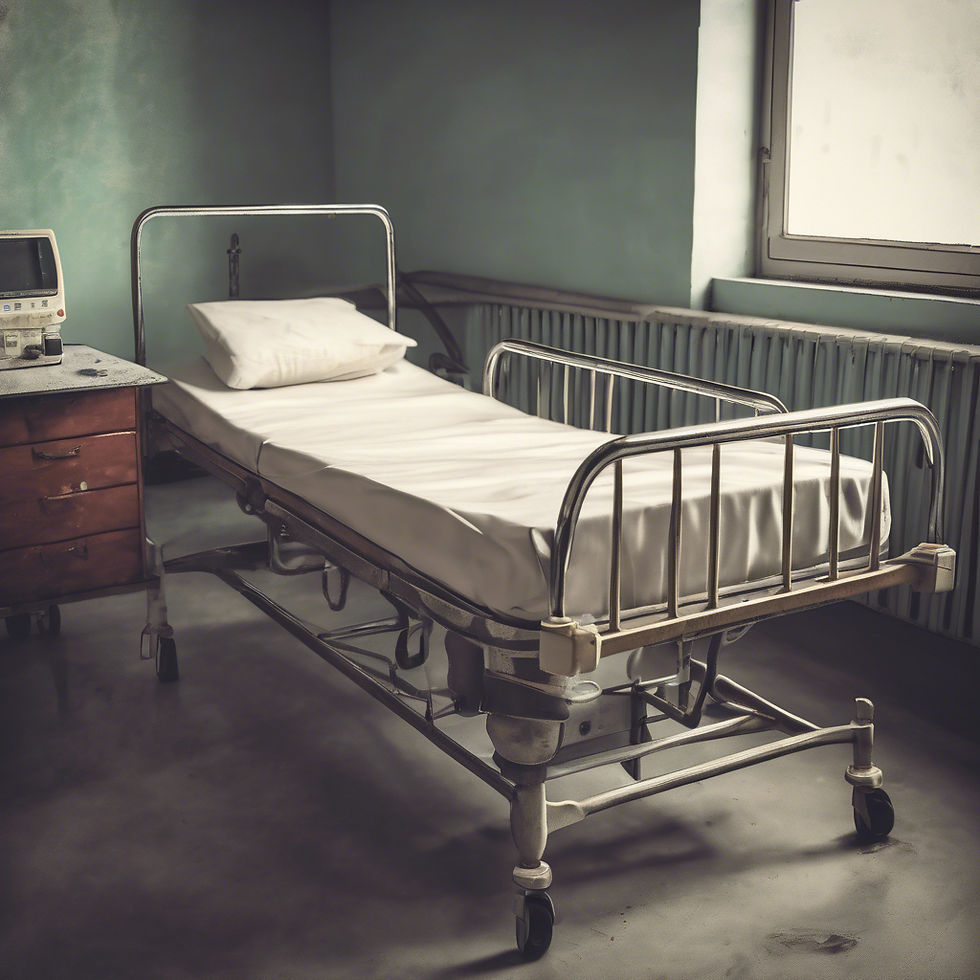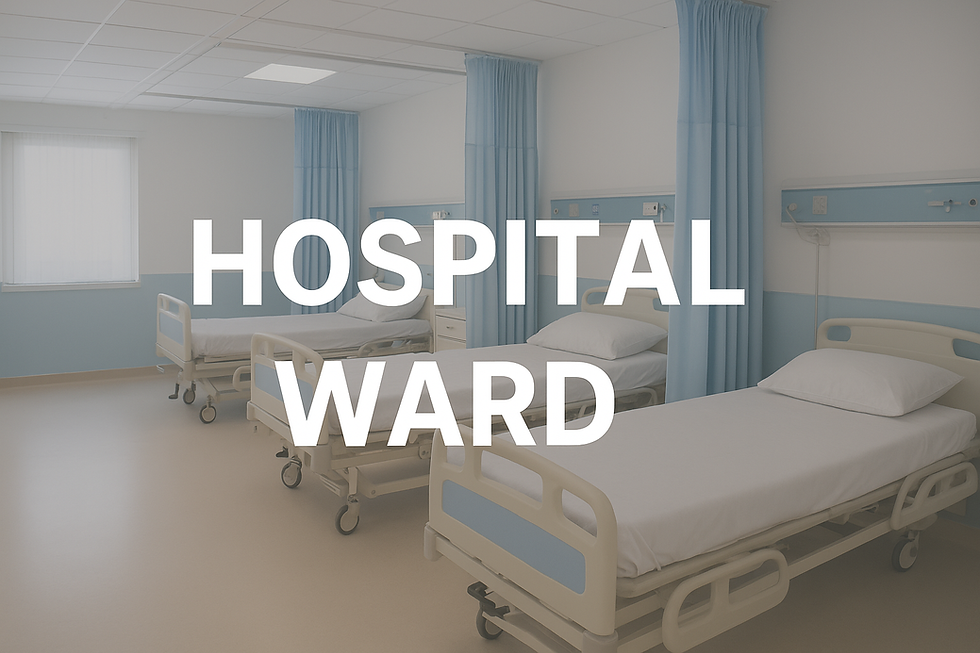The Evolution of Hospital Beds: From Basic Designs to Technological Marvels
- Dhruv Dixit
- Feb 17
- 4 min read
Hospital beds have transformed remarkably over the years, evolving from simple, manually adjusted structures to advanced, technology-driven systems that enhance patient care, comfort, and recovery. What was once just a basic frame with a mattress has now become a sophisticated piece of medical equipment designed to support various medical conditions, reduce caregiver strain, and improve overall healthcare outcomes.
Advancements in medicine, technology, and patient care needs have driven the evolution of hospital beds. Early designs were focused purely on providing a place for patients to rest, with little regard for comfort, mobility, or health complications caused by prolonged bed rest. Over time, innovations such as adjustable positions, pressure redistribution, electronic controls, and even smart monitoring systems have revolutionized the way hospital beds function. Today, they play a very significant role in enhancing both patient experience and medical efficiency.
Understanding the journey of hospital beds, let’s learn what led to the revolution of these cutting-edge technological marvels used in modern healthcare facilities.
The Early Days: Basic Frames and Minimal Adjustability

In the earliest days of healthcare, hospital beds were little more than simple wooden or metal frames with a thin mattress placed on top. There were no adjustable features, making it difficult for patients to find a comfortable position, especially those recovering from surgery or dealing with chronic conditions. Nurses and caregivers had to manually lift and reposition patients, leading to both discomfort for the patient and strain on the caregivers.
During the 19th century, as hospitals became more structured and organized, the need for improved patient care led to minor advancements in bed design. Basic inclining mechanisms were introduced, allowing for the head of the bed to be slightly elevated. This was a crucial improvement for patients with respiratory issues, as it helped facilitate better breathing. However, these beds still required significant manual effort to adjust, and patient comfort remained a secondary concern.
Adjustable Beds: A Meaningful Change in Patient Care
The early 20th century saw a major shift in hospital bed design with the introduction of manually adjustable beds. In 1909, Willis D. Gatch, an American surgeon, developed the first modern hospital bed with three adjustable sections. Known as the "Gatch bed," this innovation allowed patients to raise or lower the head, midsection, and legs, significantly improving comfort and post-surgical recovery.
The Gatch bed was revolutionary because it enabled better blood circulation, reduced the risk of pressure sores, and allowed patients to sit up without leaving the bed. However, the adjustments still required manual cranking, which could be physically demanding for caregivers. Despite this limitation, Gatch beds became widely adopted in hospitals and laid the foundation for future advancements in hospital bed technology.
The Rise of Electrically Operated Hospital Beds
By the mid-20th century, technological advancements led to the introduction of electrically operated hospital beds. These beds featured motorized adjustments, allowing patients and caregivers to change positions with the press of a button. This development significantly reduced caregiver workload while giving patients greater autonomy over their positioning.
Electrically operated beds came with several benefits, including:
Easier adjustments: Patients no longer needed assistance to modify their bed positions.
Reduced strain on caregivers: Nurses and hospital staff could focus more on medical care rather than physical labour.
Improved patient comfort: Fine-tuned adjustments allowed for more personalized positioning, enhancing sleep and reducing pain.

As hospitals began incorporating these beds into their facilities, patient care improved dramatically. The ease of adjusting beds also contributed to faster recovery, as patients could find optimal positions for reducing pain and promoting healing.
Addressing Bedsores and Circulation Issues
One of the biggest challenges in patient care has always been the prevention of bedsores also known as pressure ulcers. Prolonged bed rest without movement can lead to reduced blood circulation and tissue damage, causing painful sores that are difficult to heal.
To address this issue, hospital beds began incorporating pressure-relief mattresses designed to redistribute body weight more evenly. These advancements not only improved patient comfort but also played a crucial role in preventing complications associated with long-term hospital stays.
To overcome this major issue in the medical world, we at Aslams have innovated India's first true Auto-Regression Hospital Bed.
The Integration of Smart Technology in Hospital Beds
The 21st century ushered in an era of smart hospital beds, integrating digital technology to further enhance patient care. Modern hospital beds now feature built-in sensors, connectivity with medical devices, and even AI-driven adjustments based on patient movement and vitals.
Some of the most notable features of today’s hospital beds include:
Automated repositioning: Smart beds can detect prolonged immobility and automatically adjust the patient’s position to prevent bedsores.
Weight monitoring: Integrated sensors track patient weight in real time, helping caregivers monitor changes without requiring physical movement.
Fall prevention alarms: Beds now come equipped with alarms that notify staff if a high-risk patient attempts to get up without assistance.
Integrated vital sign monitoring: Some advanced models track heart rate, respiratory rate, and movement patterns, providing real-time health data to doctors and nurses.
These features not only improve patient safety but also streamline healthcare operations by reducing manual monitoring and intervention.
The evolution of hospital beds reflects the continuous advancements in medical science and patient care. From basic wooden frames to highly sophisticated smart beds, each development has been aimed at improving patient comfort, reducing caregiver strain, and enhancing healthcare efficiency.
At Aslam Enterprises, we are committed to providing cutting-edge hospital beds that align with modern healthcare needs. From ergonomic designs to pressure relief solutions or technologically advanced smart beds, our collection offers the best in patient care and comfort.
Explore our range today and experience the future of hospital beds firsthand.





This was such an insightful read! It’s fascinating to see how hospital beds have evolved from simple designs to advanced technological marvels that enhance patient care and comfort. The historical perspective combined with modern innovations really highlights the importance of continuous improvements in healthcare equipment. Thank you for sharing this well-researched piece! Veronica Dantas
This was such an insightful read! It’s fascinating to see how hospital beds have evolved from simple designs to highly advanced, tech-integrated models that enhance patient care. The way you highlighted the impact of innovation on patient comfort and medical efficiency was truly engaging. Thank you for shedding light on this important aspect of healthcare evolution! Looking forward to more articles like this. Sidney De Queiroz Pedrosa
What a fascinating deep dive into the evolution of hospital beds! It’s incredible to see how far we’ve come—from simple designs to high-tech solutions that enhance patient care and comfort. The integration of smart technology and ergonomic features truly showcases the innovation in healthcare. Thanks for shedding light on this transformation! Looking forward to more insightful posts from you. Beatriz Barata
This was a fascinating read! It’s incredible to see how hospital beds have evolved from simple designs to highly advanced, technology-driven systems that improve patient care. The breakdown of historical developments and modern innovations was well-researched and engaging. Thanks for shedding light on this essential yet often overlooked aspect of healthcare! Luiz Antonio Duarte Ferreira
This was such an insightful read! It's fascinating to see how hospital beds have evolved from simple designs to advanced, tech-driven solutions that enhance patient care. The historical perspective and technological advancements you highlighted really showcase the importance of innovation in healthcare. Looking forward to more great content from you! Daniel Dantas